Building a blog on your website, publishing valuable, industry-specific guides used to be just one of several interesting digital marketing strategies… In the future though, it will definitely be the most important acquisition channel for your B2B business!
Advertising costs are going crazy as more and more businesses are bidding for clicks, especially big companies who don’t even rely on profitable ads. Cookie policies on user devices and browsers make tracking even harder.
At the same time, most potential clients start their journey online, searching on Google for services, or just educating themselves on related topics.
Increasing your visibility on Google for relevant topics is more important than ever. Businesses who started early to invest in a high quality B2B content marketing strategy thrive because they’ve built their sustainable stream of warm inbound leads. That’s what this guide is all about.
Even though there are many competitors… Most of them do not follow the best practices of content marketing. So the good news is, if you start now and apply the knowledge you’ll get from reading this post you will definitely be able to increase your visibility, get more clients and become a real authority within your industry!
So let’s jump right in…
- What Is B2B Content Marketing? And What Is B2B SEO?
- How B2B Content Marketing & SEO Helps You Get More Clients
- How B2B Content MarketingIs Different From Running Paid Ads
- Why You Should Be Building a Blog a the Center of Your Digital Strategy
- The Most Important Google Ranking Factors for B2B Websites
- Step by Step Guide - How to Build Your Own Successful Blog
- Bonus Checklist - Full B2B Content Marketing & SEO Checklist
- Conclusion - How to Get Started - Workflows and Resources
What is B2B Content Marketing? And What Is B2B SEO? A Definition and The Benefits
Content marketing is a marketing method that consists of the strategic creation, distribution and promotion of valuable, unique content.
The goal in content marketing is to attract your target audience.
“Content” stands for content of any kind, for example blog posts on a website, images and videos. Youtube Videos or Instagram Posts are also considered “Content” and thus can be a part of your content marketing strategy too.
Since this post is about B2B marketing, we’ll only talk about written content for your website blog in the form of valuable, educational guides. Because it’s the most effective way to attract potential clients.
SEO stands for Search Engine Optimization, meaning the optimization of your website and your content in order to rank higher in Google. Since content marketing is also the most effective SEO measure, you can say that these terms are used as synonyms. SEO without content marketing though, does hardly get any results.
As content marketing is based on the fact that clients find you and reach out to you (instead of you approaching them), it’s a so called inbound marketing strategy.
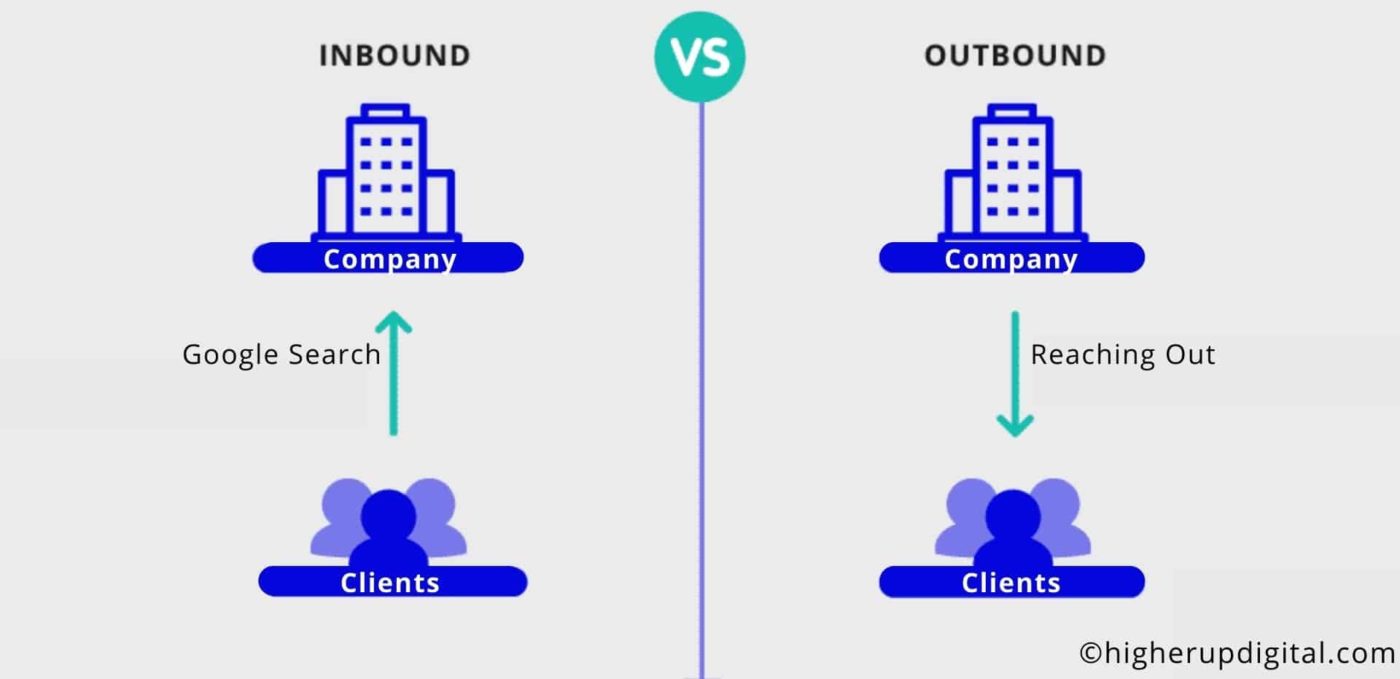
However, when distributing content through social media, newsletter or other channels, B2B content marketing can also be part of an outbound strategy.
Whether you’re distributing flyers, cold calling people, or making on-site visits as part of your sales strategy, content marketing will support your outbound efforts too. Potential clients usually check your website right away. Showing valuable content is a huge trust factor and shows proof of your expertise.
As a result, your inbound content marketing strategy will have many synergies with your outreach or sales measures too, resulting in an increased conversion rate.
How Does Content Marketing Help to Get More Clients and Increase Revenue?
Content marketing is a reliable and also sustainable digital marketing method that helps you build more reach and generate more inquiries online.
By creating and distributing content that is targeted at your target audience, your website will be found in the Google search results. On top of that, it especially gives you the opportunity to position yourself as an expert and therefore an authority in the industry you’re in.
What are other benefits?
- Build a Real Brand Asset – Your company’s value is not only measured by business metrics such as sales and profits. Brand assets like blog articles create lasting added value that no one will be able to take away from you. A company blog will increase the overall value of your business significantly.
- A Stream of Inbound Leads – Whoever finds your website through content marketing will be more likely to become a client or customer than someone that you reached out to who don’t even know anything about you or your business. Why? 1. they’ve already been showing interest and 2. you’ve already had the chance to convince them with your content – providing value for free.
- You Can Charge Higher Prices – Since you have already proven your expertise with your content, prospects will trust you and view you as an authority. Therefore, new clients will be more likely to convert and also pay higher prices. It’s your ultimate ticket to escape the never ending price-war with competitors!
Building a successful B2B brand by positioning yourself as an expert with valuable content will sustainably increase your revenue!
How Is B2B Content Marketing Different From Running Ads on Google or Facebook?
It’s important to understand the real value of content marketing and why it’s completely different from other digital marketing measures such as Google Search Ads. Content marketing has compounding effects and builds a real long term asset, results need longer to show. Running ads on Google or other platforms in comparison will show results immediately.
The Return on Investment though, especially regarding a long time comparison is much lower in general – because your content can get you results for years and years to come even after stopping new content creation.
One reason being the ever increasing cost per click spendings due to increased demand and competition. Another issue though is the dependance though, that will develop. A fully dependence on paid ads is like a business on life support. The moment your ads shut down – your marketing success will go back to zero.
The following graphic illustrates the differences showing a theoretical example of a Google Ads campaign at a $ 10.000 one-time budget in comparison to a $ 10.000 content marketing budget. The newly created content will slowly increase in ranking, showing its true effects delayed after 6-12 months. Google Ads will show results right away, but will go back to zero after shutting your ads down.
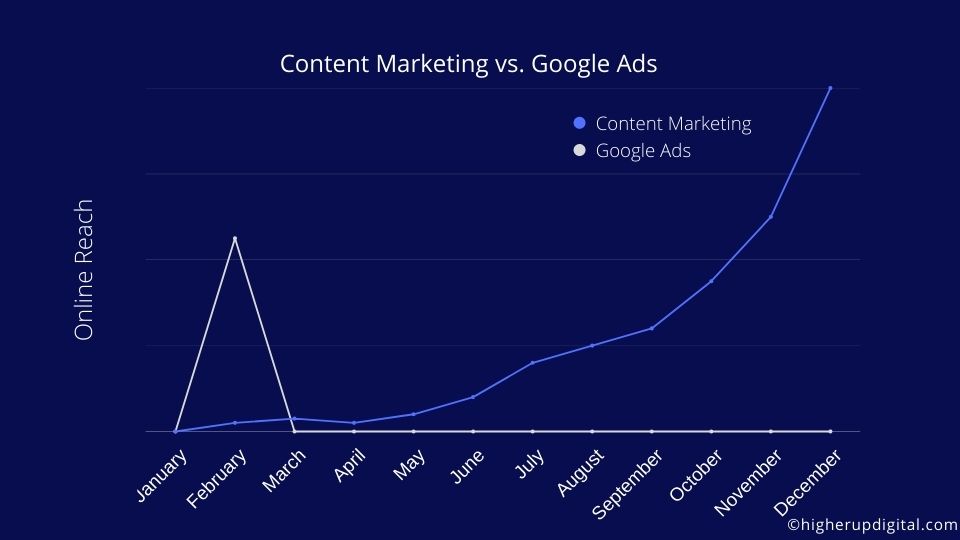
Content marketing is a lot more sustainable and can achieve a significantly higher return on investment. According to an extensive study by Ahrefs, examining over 2 million Google keywords, it takes an average of several months, to rank on the first page of the Google search results.
From our own experience, it is even possible to build up a significant stream of page visitors and rank on the first Google search results in less than a year – especially in smaller niches. Still you need to bring some patience in comparison to running ads.
Your Digital B2B Marketing Agency
Creating Content for Your B2B Website Means Building Your Own Asset - Rather Than Renting It
Online traffic can be compared to streams of customers in a local shopping street in the city center. Advertising via Google Ads or Facebook is like a store lease.
In order to successfully operate your business, you will have to pay your rent or maybe even commissions and other payments every month. If you stop paying, you will be kicked out, your retail store will be gone and so will your customers.
Content marketing on the other hand offers you the opportunity to gradually build up your own retail store as your own property and asset.
Your property may be much smaller than the rented ones next door but it will grow over time… With every blog post you publish… And without a raise of the lease! You’ll gain independence and build up a real brand asset. See the illustration for reference!
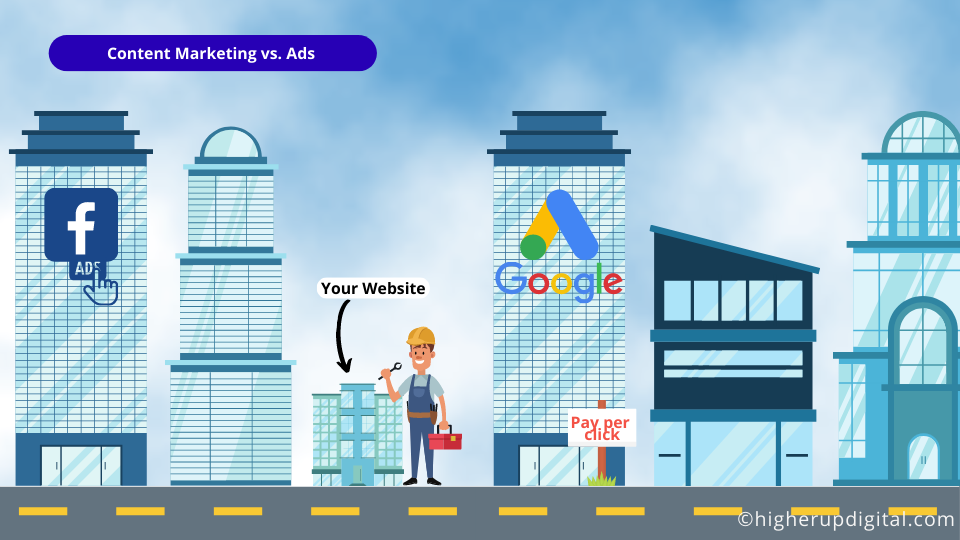
B2B Content Marketing Has Compounding Effects - It's Like a Business Flywheel
The flywheel effect is what all digital businesses are seeking. It simply means creating something that compounds and leads to exponential growth – instead of linear growth.
Creating new content on your post every week, sharing it on social media, sending out a short teaser linking to your new post via newsletter are measures that have strong synergies. Look at the flywheel graphic below
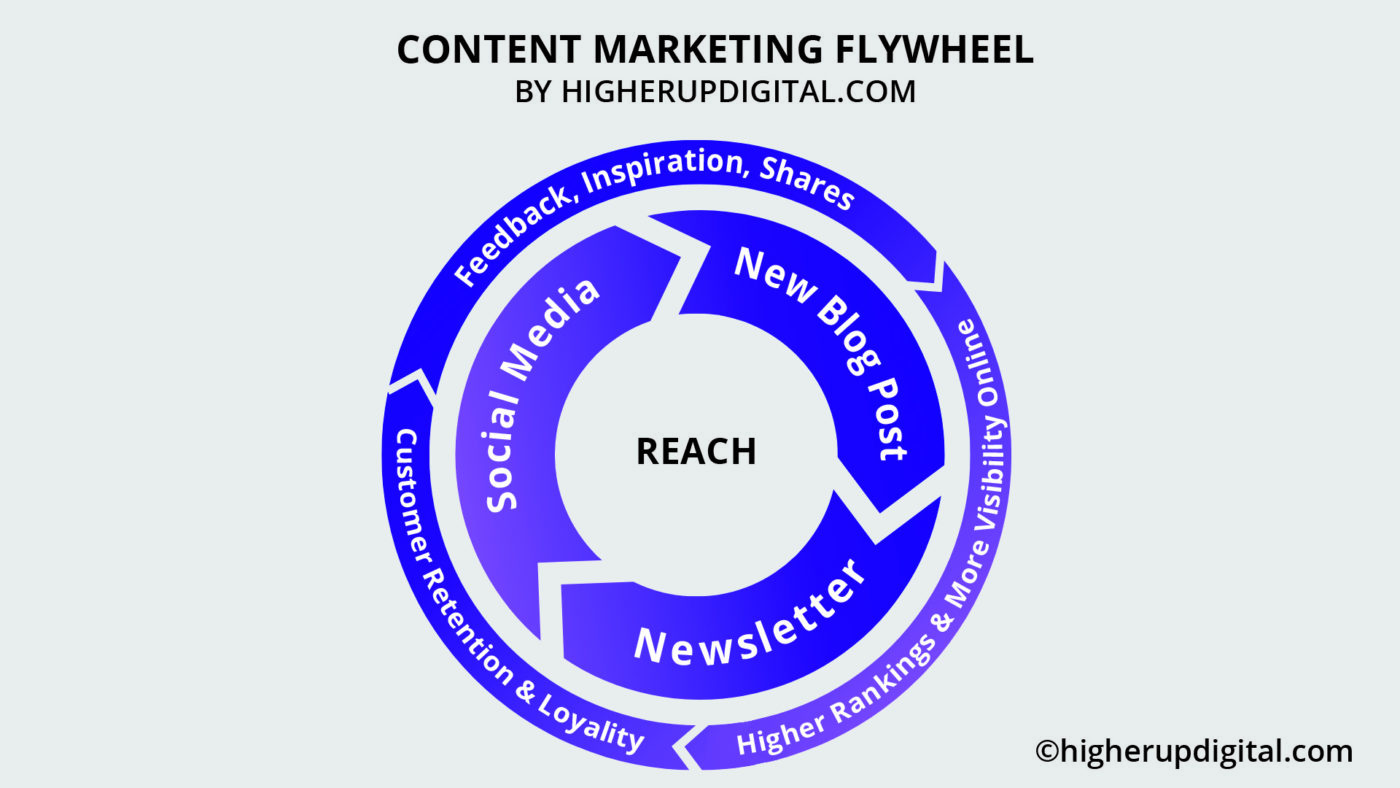
How exactly does the Content Flywheel work? Following the sequence of content creation and content promotion over and over again will lead to exponential growth over time.
Because with every new post, your followership on social media will grow, the number of newsletter subscribers will grow, your website authority will increase – making new posts rank faster and higher right from the start. Sticking to this routine, delivering output constantly will help you grow your visibility exponentially.
To further illustrate this effect, check out the chart below. The first 30 posts might be extra hard because you’ll have to learn and execute many things simultaneously. If you continue and stick to it, the next posts might lead to exponential growth!
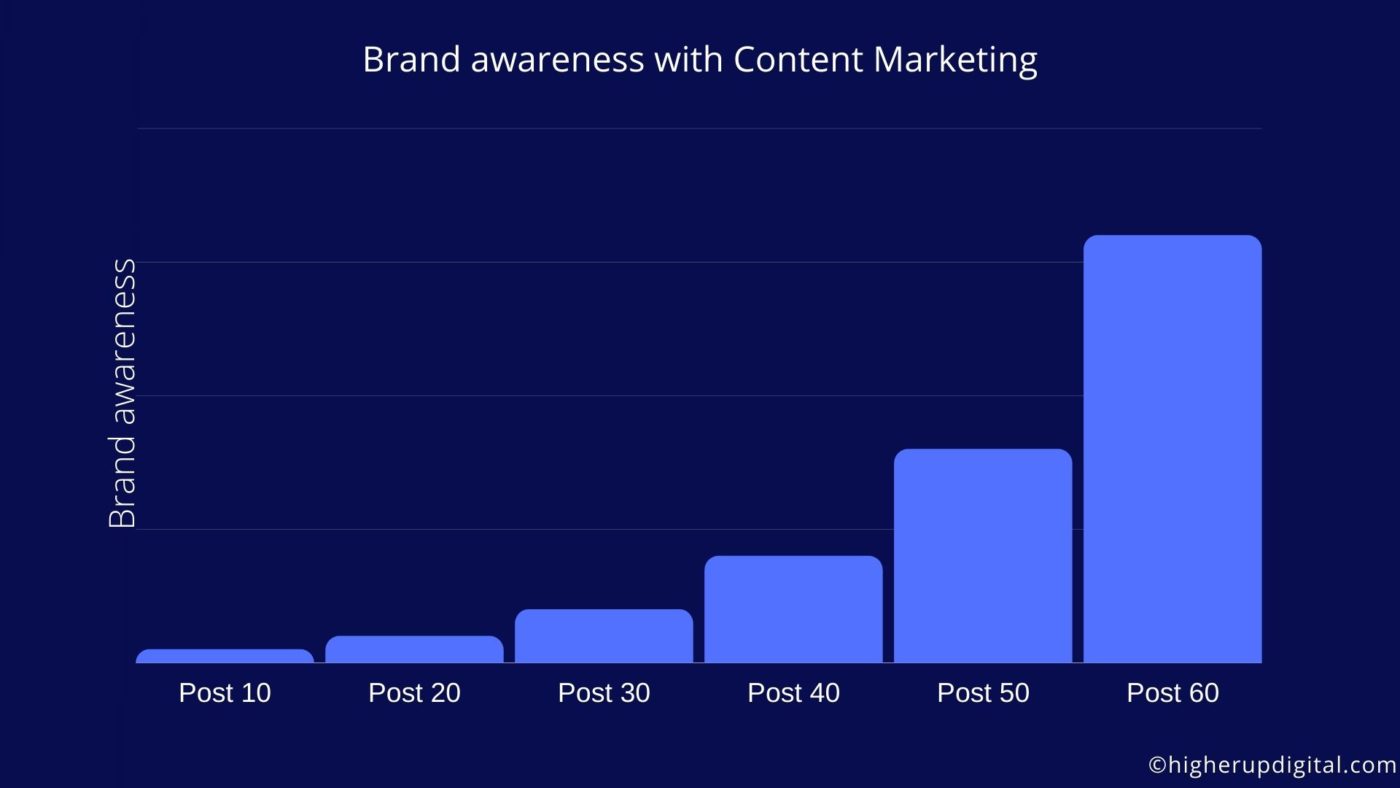
Why We Recommend Building a Blog as the Center of Your B2B Content Strategy
No matter which channels you use for your digital marketing strategy, be it Youtube, a podcast or LinkedIn – your website blog should be the center of your B2B content marketing strategy. You should always link to your website or even embed content like Youtube videos into your website, because this is where you need to draw peoples attention to.
Your website is your own universe where you can educate prospects about the services that you offer and the reasons why someone should work with you – without the distractions that you’d have on any other social media platform!
The following image shows where and how a blog should located on your website.
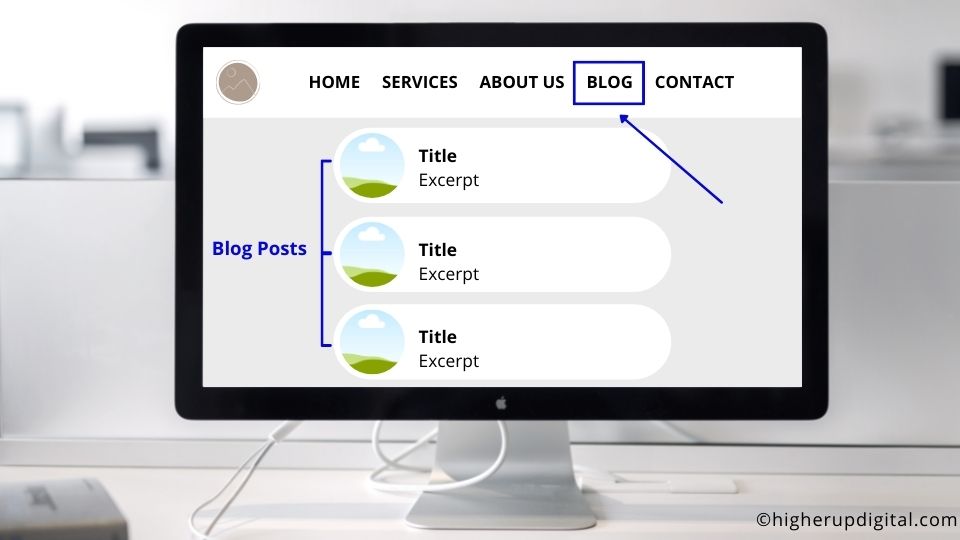
A header navigation menu endpoint “blog” should link to your blog archive, showing the latest posts.
We recommend to call it “blog” and not “magazine” or anything similar. This way, people will immediately understand what to expect.
The biggest advantage: Your website doesn’t appear next to a number of other profiles that you have to compete against. This way it will be so much easier to convince your visitors that you offer exactly what they are looking for.
Another plus is that Google has by far the largest reach in comparison to all other platforms. So you will reach the biggest audience through your blog.
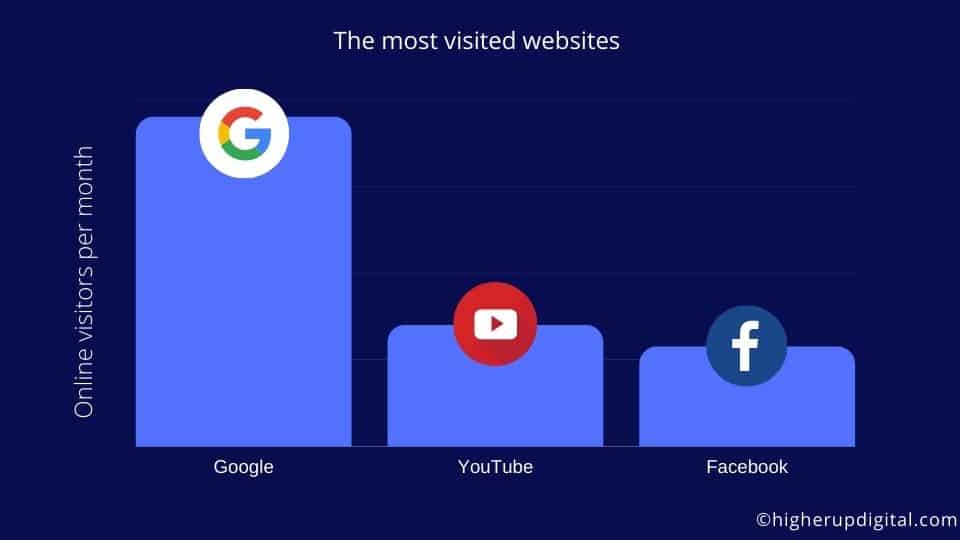
The Google SEO Ranking Factors for Your B2B Content Marketing Strategy
Content marketing and Search Engine Optimization (SEO) go hand in hand.
Contrary to what many assume, SEO does not mean manipulating a website technically to get a better ranking position. Gone are the old days when it was possible to trick Google, for example by placing tons of keywords in a blog post or buying cheap links from other websites.
Today, the main ranking factor is quality. Content that provides real value for your website’s visitors. This might frustrate the old tech or keyword focused SEO agencies – because it needs much more work, skills and effort to create high quality content! Most search results on Google that appear on the first page are information-based articles such as blog posts.
A study for which 11.8 million search results were examined, found out some of the most important ranking factors:
- Total Word Count – The average word count of pages that appear on the first page of the Google search results is about 1500 words. This means you should be aiming for blog posts that are between 1000 and 2000 words.
- Real Value and Expertise – As the word count suggests, in-depth content is more successful than short posts in general. This doesn’t mean that all short posts are useless, but it suggests that users prefer comprehensive guides. Whoever manages to provide the best answer to the users question wins, and ranks higher. Analyzing the users search intentions is one of the key factors for success.
- Dwell Time and Scroll Depth – The study has shown that the dwell time on a post is a particularly important signal for Google. If users find exactly what they have been looking for in your blog post, then they will stay on your website longer, and scroll. Hence, keeping visitors engaged is important, too.
As you can see, in order to rank high in Google search, you need to know exactly which questions and problems your target audience has, and reflect them in a structured way. Google rewards content that matches the users’ search intention.
So it’s no surprise that mostly informative blog posts like guides rank high.
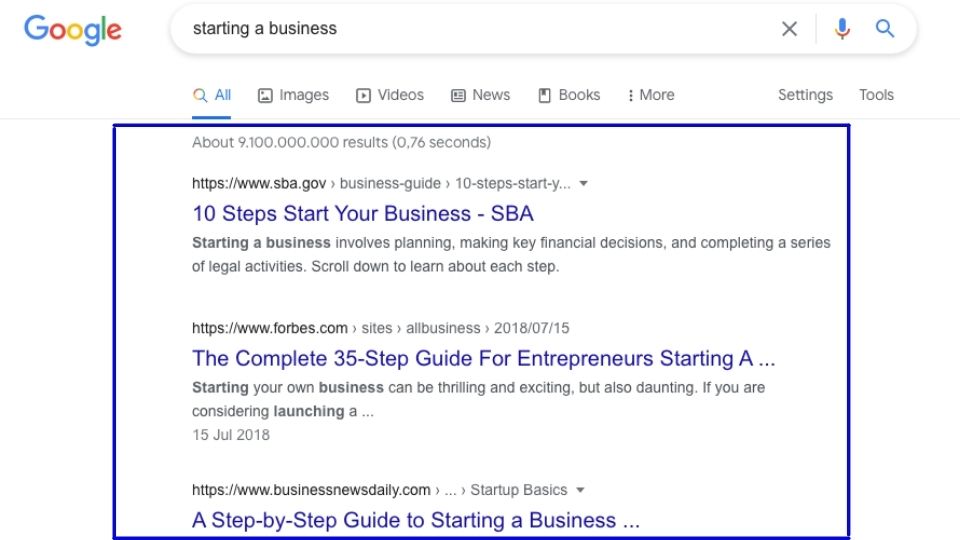
As you can see, B2B SEO and B2B content marketing are basically the same thing.
Producing high quality content for your blog is the most important foundation to grow your visibility online. Your content still needs to follow Google’s guidelines as well as SEO best practices.
What matters the most though is analyzing the search intent and completely nailing it by creating a catchy post Title and meta description. More about finding topics, content optimization and a pre-publish checklist later on in this guide.
How to Build Your Own Successful B2B Blog - Full Step by Step Guide with Examples
Now you know the potential of content marketing and that in order to succeed, it’s important to match the users’ search intent. But how do you write good blog posts that will provide value, answer your users questions and rank high on Google?
And how do you even find a topic to write about?
Blogging for business / B2B blogging is fundamentally different from private blogging. In order to really provide value and generate leads, your content needs to be specifically aimed at your target audience and be relevant to your business.
We’ve created a full step-by-step guide for you that includes the best practices of B2B content marketing, providing all the knowledge you need to get started.
1. Define Your Target Audience And Create a Customer Avatar/Persona of Your Ideal Client
The better you can imagine your target audience that you are writing for, the better you can actually target your content to them.
We recommend creating a client avatar/persona. A client persona is a detailed description of your desired client. To create it, take a pen and piece of paper. Give the person a real name, e.g. Josh Brown. This is much easier when you know your clients personally and have some examples in your mind already!
Write down details about this person like
- Their Personal Characteristics – What drives and motivates them? What distinguishes them from other people? What language/slang do they speak, meaning which terminology is used within the target audience? Formal or informal? What kind of people do they surround themselves?
- Their Biggest Problems – What keeps them up at night, both from their private life and also professionally? (e.g. Small agency owners who are lacking predictability with their client generation)
- Their Individual Goals – What would a picture of their perfect future look like? What are their personal goals and dreams? (Save time? or Get rich?)

A dentist’s target audience for example are people with dental problems like a toothache who are searching for their issues online.
Patients are usually looking for a caring doctor, who will understand their problems. The better you can narrow down the needs of your target audience and the better you will understand how a blog post can bring you and your target audience together.
In other industries, as in B2B, the basic needs are often very similar. Small business owners usually want to grow their business and make more sales without having to work hard. Now it’s your turn. Draw a picture of your ideal customer!
Pro Tip: Take at Least 30 Minutes to Finish This Task
This task is essential for all following steps and also for your overall marketing success. We often see our clients underestimate the meaning of this exercise and how important and beneficial it is for your business! Questioning your clients and target audience will improve your business success right awway, it's an ultra-high ROI thing to do. So take your time and put in the work!
2. Perform a Topic Research: How to Find Topics That Are Really Relevant And Attract New Clients
After you have clearly defined your target audience, you can move on to the next step: Topic Research.
Topic research is not just about finding any topics. It’s important that the topics you write about are relevant to your target audience. But that’s not the only kind of “relevance” there is! The topics that you’ll write about should be important for your actual business too! Otherwise, you’ll get clicks that are worthless and not bring any new clients or revenue for your company.
The most simple approach to finding new topics that are relevant for your business is looking at the services you offer on your website – and then listing topics under each service.
A graphic design agency that offers logo design could write about “How to Develop a Company Logo in 5 Simple Steps”. Always make sure the topic you pick could be listed underneath any service you provide.
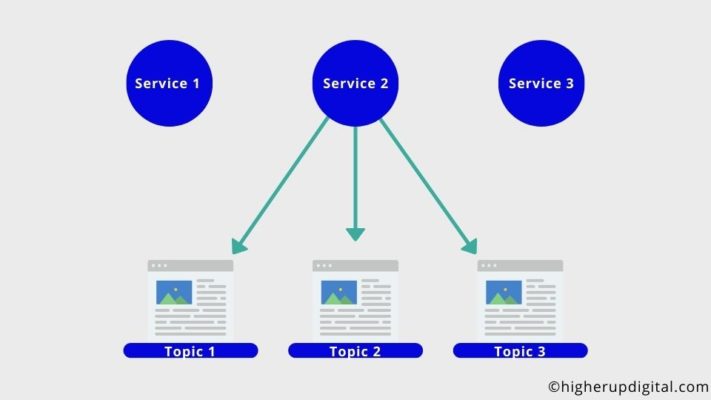
- Relevant for Your Clients – To check wether a topic is relevant in general, start out by searching for the topic on Google. Make sure to use synonyms and variations. If there are competitors that already cover these topics, then that’s a good sign! We’ll cover keyword research later on in this guide…
- Relevant for Your Business – What’s the point of generating page visitors who have no interest in your services at all? Therefore specifically assign each topic to a service that you are offering.
We provide Content Marketing & SEO Services for Your B2B Company
3. Keyword Research: How to Know Which Key-words Generate Traffic for Your B2B Blog Post?
Once you have found a topic to write about, it’s time to find out which keywords or search terms your clients are actually searching for.
Consider the keyword research as an additional step to validate your new topic ideas. The goal is to get a feeling for the actual demand and potential.
Attention: It's Not Only About Search Volume
There are several limitations to a data-driven keyword research. For many niche-terms, keyword tools won't even show any information here or only show "0" - but that doesn't necessarily mean the topic isn't a good choice. That tool could either not show accurate data, or you are simple one of the first writing about this topic. Sometimes this can be a good thing too!
How Do You Find Suitable Keywords for Your Topic?
First of all, put yourself in the position of a potential client and ask yourself what you would type into the search bar on Google to find the answer you are looking for.
Take note of what terms your competitors are using and what other search suggestions Google is displaying in the “related searches” – located on the bottom of the search results page. These terms are part of the “Google Suggest” terms, the same that you would see on the auto suggest keywords.
the free tool Answer the Public can be very helpful in this matter too. It displays Google searches and combines them with different words.
After creating a list of suitable search terms that you found, you can continue to check these for their search volume estimate using a tool
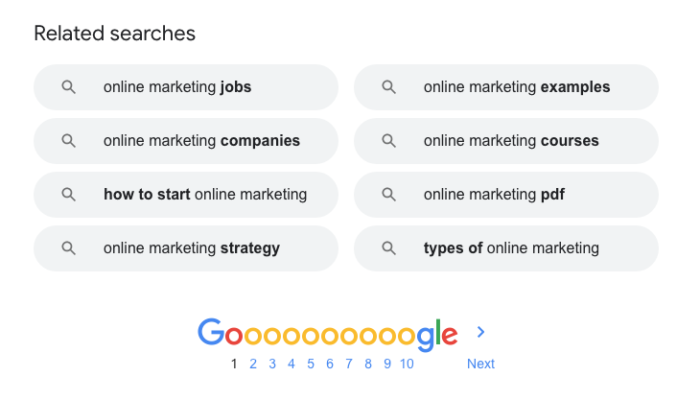
How to Use Tools for B2B Keyword Research
We recommend the following tools for checking search volume estimates:
- Ubersuggest – The basic version of this tool is free of charge. It will give you keyword ideas and their estimated search volume. It has a free plan or starts at $ 29 monthly for full data view, which makes it one of the most affordable tools.
- Ahrefs – This tool is not for free but will offer the best results. Using their own website crawler system, they can provide the most accurate data. Plans start at $ 99 per month. We use Ahrefs for our own projects as well as our clients.
Below you can see an example estimate for keywords relevant to the guide that you are reading right now provided by Ubersuggest.
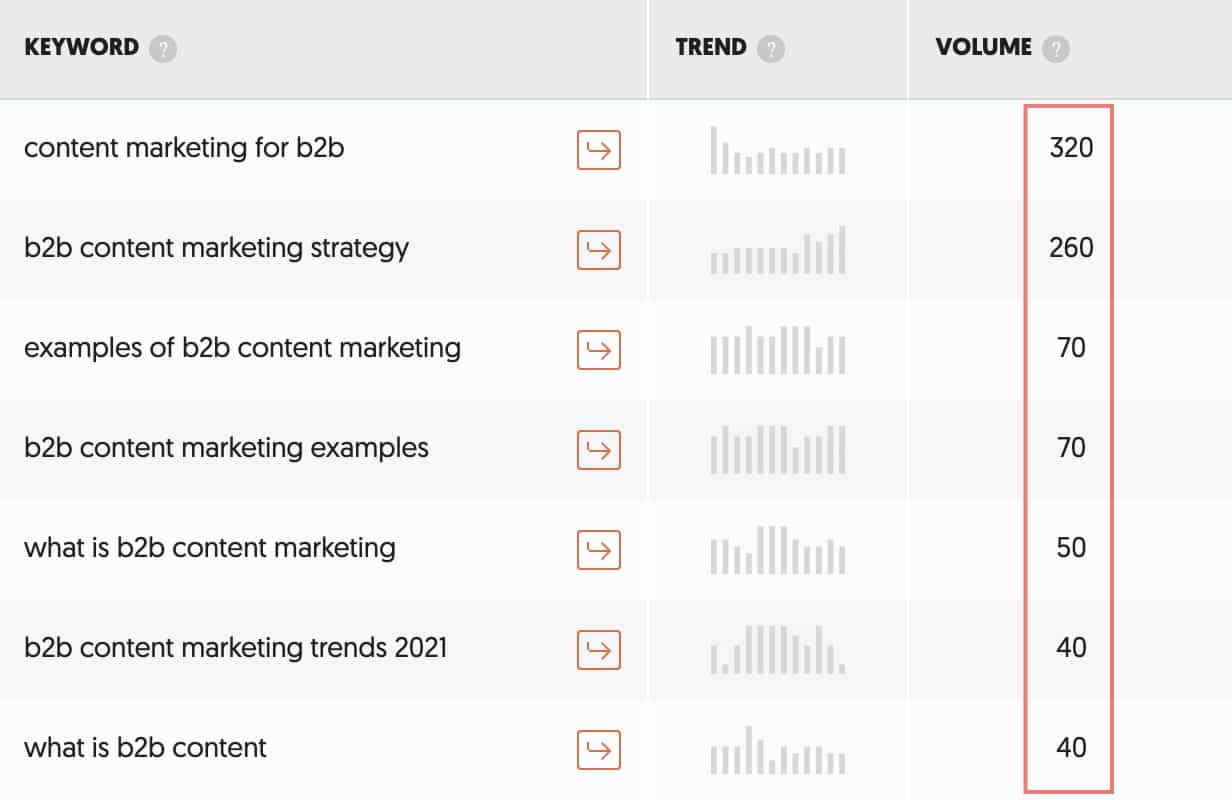
4. The Anatomy of a Successful B2B Blog Posts - Content Type, Structure and SEO Optimization.
After deciding for the topic and picking 3-5 relevant keywords, it’s time to get to work creating your blogpost.
The keywords that you just picked should be placed within the titles of the post to give Google a hint. Since Google recognizes synonyms, it’s not necessary to spam your keywords, but it still helps to place them in your headlines.
The following types of B2B blog content are the most successful ones, statistically and that is for a reason – they are catchy and easy to consume.
- The How-to-Guide / Ultimate Guide – This type makes the topic easy to understand for your target audience by chopping extensive information down into small chunks. For example “The Ultimate Content Marketing Guide: How to Write Blog Posts That Rank on Google”.
- The List Post / X Steps Guide – This kind of structure helps your readers to easily estimate the depth or length of a post. It makes it sound attractive since everyone can follow a step by step guide. Examples: “The 5 Best Content Marketing Tools”, “5 Simple Steps to Improve Your Rankings”, “Top 7 Reasons to Start Cold Calling”.
Now you’ve learned which types of content and especially which types of blog post titles work well for B2B guides. No matter which format you’ll use, you should also follow the following structure to keep your readers engaged and continue reading:
The Preview and The Pitch – You should introduce the topic and “sell” your post. Most people will decide in the first few seconds whether they will stay on your page and keep reading or not. Give a preview, and a pitch on why they should continue reading. For example “In this article you will learn how…” or “After reading this post until the end, you will be able to….”
The Main Content – Step by Step Guide – The actual Guide should follow a clear structure, ideally in a step by step formate which is easy to follow. Make sure to use clear headlines that summarize each chapter. Most readers will skim through the content and only read the headlines or single chapters, not your entire post. we recommend 800-3000 words per post, depending on the depth of the topic.
The Conclusion and Call to Action – Quickly summarize the essence of your post for the lazy “too long didn’t read” people. Just like the backside of a book cover, many readers will read the conclusion to get a quick summary. Thats why you should also place a clear call to action in your conclusion.
Note: What Makes a Good Call to Action
A call to action can be any form of asking the reader to take action. But a good CTA is defined by the value that you can offer right away. For example a free demo, a strategy session, a free sample of anything etc. Give your reader a clear and easy to undersand reason why they should reach out now.
5. Internal and External Linkbuilding for Increases Your Website Structure and Improves Authority
Using links to credible sources will not only prove your point but also ensure that your blog posts rank higher on Google. Linking to strong external resources is a positive signal that your content is trustworthy.
You should also link to related blog posts from your own blog (internal links). Wherever you are using a call to action, you could also link to your service description pages whenever it makes sense.
To give you a rough rule of thumb, you should aim to insert at least 3 internal and 3 external (outgoing) links per blogpost. The following graphic gives you an overview of how to build internal and external links.

6. All You Need to Know About On-Page SEO Optimization - Post Your Blogpost on WordPress
We recommend writing the post within a text editor, preferably Google Docs for easy collaboration. After finishing and proof reading your new piece of content, it’s time to upload it on your website and make it look even better.
At HIGHER-UP Digital we only work with WordPress, since it’s the most popular, most widely used content management system worldwide and statistically provides the best SEO results. Let’s get started publishing your new post!

- Heading H1 – Remember to choose a catchy post title. The title is usually the first thing your readers will see. Make sure to include the most important keywords in the title as well. 12-18 words are ideal.
- Featured Image – Choose an image that fits the post. You can use free image databases like Canva. On Canva you can create infographics with just a few clicks and without any prior knowledge in graphic design.
- Heading H2 – Always choose H2 as the highest main heading in the post, as the post title is already the H1 heading and every page should only have one H1.
- Body Part – The body has the formatting “paragraph” and should always be subdivided into various paragraphs for better readability. Use internal and external links whenever possible to strengthen your link profile and authority.
- Heading H3, H4, H5, H6 – For headings that are lower in hierarchy, use the “H3” formatting. We generally don’t recommend going deeper than H4.
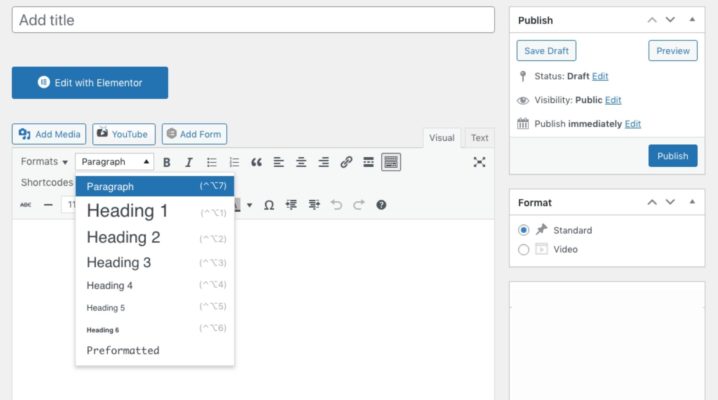
Every post has its own meta title and meta description. This is the preview of a website that you see in the Google search results page.
It’s very important to optimize your meta title and description. It should briefly describe what the page or in this case a post, is about. Ideally, check which approach your competitors are using to seek inspiration.
Don’t copy – try to stand out!
Make full use of the limited space available of 60 characters for the title or 160 characters for the description. Free WordPress plugins like SEOPress (our plugin of choice) let you easily insert the meta description directly on your edit-post page within WordPress.
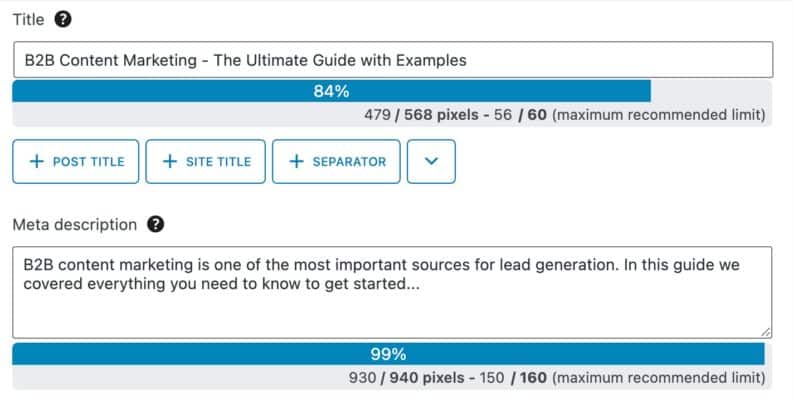
Next to your meta title and meta description field you will also find a preview, for mobile and desktop view.
Check out the preview to get a better feeling of how the final result will look like. Make sure it’s catchy and ideally a bit persuasive!

When creating a new post in WordPress, the URL slug is automatically created from the first headline. The slug consists of the terms after the “/” in your URL. Since Google is only showing the first few characters of your slug, it is recommended to always shorten it. A comprehensive SEO study, analyzing 11.8 million websites showed that short URLs/slug tend to perform better and rank higher.
You can edit the page within your WordPress post editor too.
Make sure that the slug does not consist of more than three hyphenated words, and the most important keyword is included. Don’t overthink it though, and don’t change it for old posts that already rank since it could cause more harm than good.

Congratulations! You’ve successfully uploaded and optimized your post.
Later on in this post you will find our complete pre-publish checklist which you can use as a template for all future posts to make sure you won’t ever forget any of the crucial steps we just exmplained.
Pro Tip: Ask Your Colleagues or Clients for Feedback!
Even shortly after the publication of your post, you can still make changes to the post without harming your rankings - since the post won't rank immediately. Use the first few days to get honest feedback from colleagues or clients. This way you can easily find out whether there is something you may have overlooked. Ask them to be completely honest with you!
7. Analazye and Update Your Blogposts Regularly - Google Loves to See Ongoing Optimizations
Evergreen content that is relevant for years – often even for decades is one of the best ways to benefit from your content strategy over a very long time and get the most out of its compounding effects. Google loves posts that have a long time history, long dwell time and just good statistics. On the other hand, you need to make sure to keep your content updated.
With Months and years passing by, there might be new best practices, new technologies, new laws that might make your post look more and more outdated. Also, you might have learned new insights about a topic, or your competitors did simply create a post that is a bit better than yours.
We highly recommend using the Google Search Console to analyze your content. You’ll see which post has grown or decreased in impressions and licks over time. This allows you to update and optimize your most successful posts at regular intervals (e.g. quarterly) or to gain insights about new topics.

Bonus: The Content Marketing Checklist - From Topic Research to SEO Optimization
- Topic Research – Look for a topic that is relevant to your clients. Make sure it is relevant for you and your business as well! Look at your service portfolio and go from there…
- Check Search Volume – Use tools like Ubersuggest or Ahrefs to conduct a keyword research. Aim to find keywords describing your topic and check their search volume. Every post should have 1 primary and 3 secondary keywords
- Research Content – Start with the content research for your blog post. Use your identified keyword for a Google search and check out the top 5 search results. See what they are doing, which audience they are targeting and the content.
- Create an Outline – Outline your new post, start by creating the headlines and then add bullet points to summarize every section. Insert the the keywords in all headlines to give Google a hint right away.
- Write the Post – Then write out your blog post in a Google Doc. The post should consist of at least 600 words and go up to 3000 words, depending on the topic.
- Spell & Grammar Check – Check your post for spelling & Grammar errors.
- Set a Post Title in WordPress – Choose a title that includes the main keyword and sounds catchy. We recommend drafting at least 4 versions and then pick the best one. Enter the title in a new WordPress Post
- Assign Category – Assign a category to the post.
- Set Featured Image – Set a featured image to appear in the beginning of the post. If you want, you can also add other images to the post.
- Shorten the Permalink / URL Slug – Shorten the permalink located under the post title. Use the main keyword and shorten it to max. 3 words. Just like we did https://higherupdigital.com/b2b-content-marketing
- Insert Content – Paste the content, either directly within the WordPress editor or any page builder that you are using.
- Text Styling – For the headlines in the post, choose the “Heading H2” or “Heading H3” format, depending on the level. Insert bullet points. The rest should be in the paragraph format.
- Insert Links – Add at least 3 internal links (links to your own posts or pages) as well as 3 external links (links to external website, ideally authoritative and credible sources of your choice). Make sure that all links work.
- Create Meta Title & Description – Define a meta title but make sure it doesn’t exceed the given number of characters or pixels. Aim for a catchy title containing top keywords.
- Publish the Post – Publish the post and make sure everything looks well. Read through the entire post – try to view it through your clients eyes.
- Seek Feedback & Optimize – Before promoting your new post via LinkedIn or sending it to your newsletter list, ask your colleagues or clients for feedback.
Increase Your Website Traffic Now
Conclusion - How to Start and Implement Your B2B Content Marketing Workflow
In our opinion, content marketing is the best B2B marketing method if you want to focus on sustainable and cost-efficient lead generation and brand building. Companies who get inbound leads from their content marketing strategies can charge more and basically pick their ideal clients – that’s a fact!
Some businesses started investing into high quality content marketing many years ago. Many of them absolutely dominate their markets today. But it’s not too late, since most businesses haven’t even started yet.
Many entrepreneurs know exactly how content marketing works in theory but still don’t have a successful blog on their website. How come?
The answer is simple: They are not willing to put in the work!
Content marketing is about doing.
Since it does not only take experience and know how, but also time and energy, many businesses fail producing content. It’s just too much hassle if you need to focus on your core business simultaneously. We recommend either putting together a dedicated content marketing team – or outsourcing the entire work to a specialized B2B content marketing agency like ours.
We’d love to learn more about your situation and help you assess the potential for your current situation. Act now – and schedule a free strategy session or reach out using our content form. We’re looking forward to hearing from you!




